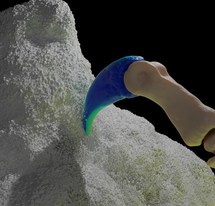We reach more than 65,000 registered users in Dec!! Register Now

Dinosaur claws used for digging and display
- March 03, 2023
- 52 Views
- 0 Likes
- 0 Comment
Dinosaur claws had many functions, but now a team from the University of Bristol and the Institute of Vertebrate Paleontology and Paleoanthropology (IVPP) in Beijing has shown some predatory dinosaurs used their claws for digging or even for display.
The study focused on two groups of theropod dinosaurs, the alvarezsaurs and therizinosaurs, that had weird claws whose function had been a mystery up to now. It turns out that alvarezsaurs used their rock-pick-like claws for digging, but their close relatives, the giant therizinosaurs, used their overdeveloped, metre-long, sickle-like claws for display. Alvarezsaurs claw digging dirtShuyang Zhou for the 3D modelling and functional scenario restoration
Alvarezsaurs claw digging dirtShuyang Zhou for the 3D modelling and functional scenario restoration
The new work is led by Zichuan Qin, a PhD student at the University of Bristol and the IVPP. He developed a new, computational approach in biomechanics to identify functions based on detailed comparison with living animals. First, the claws were modelled in three dimensions from CT scans, then modelled for stress and strain using engineering methods, and finally matched to functions of pulling, piercing and digging by comparison with modern animals whose claw functions are known.
“Alvarezsaurs and therizinosaurs are definitely the strangest cousins among dinosaurs,” said Professor Michael Benton, one of Zichuan’s supervisors. “Alvarezsaurs were the tiniest dinosaurs ever, the size of chickens, with stubby forelimbs and robust single claws, but their closest relative, the therizinosaurs, evolved in the exact opposite path.”
“Therizinosaurus is famous for its sickle-like claws, each as long as a samurai sword: Edward Scissor-hands on speed. We all saw Therizinosaurus in ‘Jurassic World’ hitting deer and killing the giant predator Giganotosaurus. However, this is unlikely. These long, narrow claws were too weak for combat.” said Dr Chun-Chi Liao, an expert on therizinosaurs from IVPP who co-authored this study. “Our engineering simulation shows that these claws could not withstand much stress.”
“Not all therizinosaur hand claws were so useless in combat, but most other related species could use their claws as powerful hooking tools when feeding on leaves from the trees.”, Dr Chun-Chi Liao added, “so, we conclude that the largest claws of any animal ever were actually useless in mechanical function, and so must have evolved under sexual selection to be used in display. The adult Therizinosaurus I guess could wave the claws at a competitor and effectively say, ‘look at me, back off’ or wave them around in some way like a peacock can use its tail in display to attract females for mating.”
“Our previous work has shown that alvarezsaurs evolved to become the tiniest dinosaurs by the end of the Cretaceous, and these dinosaurian midgets were using their punchy little claws for digging into ant hills and termite mounds. They were ant-eaters.” said Zichuan Qin.
“Our study shows that the early alvarezsaurs, like Haplocheirus from the Jurassic, had multifunctional hands, but they were not good at digging. Their much smaller descendants had the efficient digging hands so they could feast on the Late Cretaceous termites.” added Zichuan Qin.Silhouettes show the large and elongated forelimb of the late-branching therizinosaurian Therizinosaurus (a) and the overall body shape and highlighted forelimb of the late-branching alvarezsauroid Mononykus (b), scaled against an adult human (height ~1.8 m). The work pipeline demonstrated by an ungual model from the Jurassic alvarezsauroid Haplocheirus, includes processes of 3D model reconstruction (c); model smoothing, measurement, and morphological analysis (d); finite-element analysis, ‘intervals’ method and functional-space analysis (e); and total evidence functional
“Science and technology cannot bring dinosaurs back to life, but advanced computing and engineering techniques can show us how extinct animals lived,” said Professor Emily Rayfield, one of Zichuan’s supervisors, and an expert of dinosaur biomechanics. “Especially for extinct animals like alvarezsaurs and therizinosaurs, they are so bizarre that we even can’t find any living animals like them. Luckily, advanced technology can help us to simulate, on a computer, the functioning of extinct animals using fundamental engineering and biomechanical principles. This study shows very well how selection for function can lead to the emergence of specific, sometime very bizarre, forms.”
List of Referenes
- Zichuan Qin, Chun-Chi Liao, Michael J. Benton, Emily J. Rayfield. Functional space analyses reveal the function and evolution of the most bizarre theropod manual unguals. Communications Biology, 2023; 6 (1) DOI: 10.1038/s42003-023-04552-4
Cite This Article as
No tags found for this post









